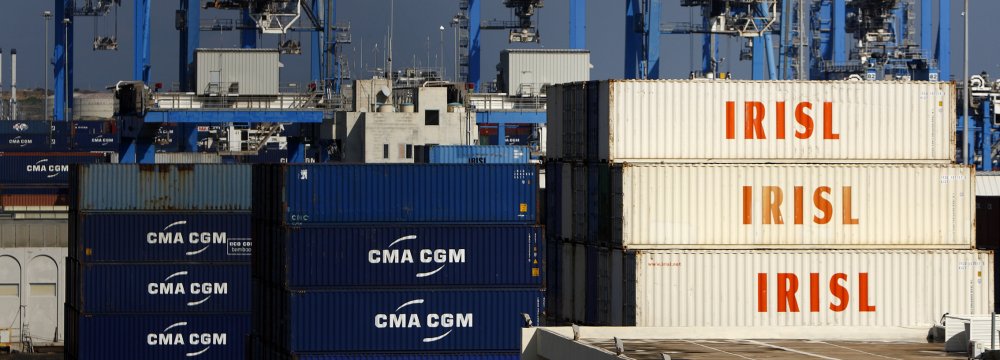
Iran-EU Trade Doubles

Exports to the EU’s 28 states stood at €6.5 billion, about 2.4 times more than in the same period of 2016, Eurostat data show, as reported by the Economic Studies Department of Tehran Chamber of Commerce, Industries, Mines and Agriculture.
Iran imported €6.6 billion worth of commodities from the European Union, recording a 37.5% rise year-on-year.
Petroleum, petroleum products and related commodities accounted for the majority of Iran’s exports to the EU during the period (more than 88%), with a total value of €5.7 billion, registering more than a threefold rise YOY. Food exports stood at €224 million, indicating a 13% decline YOY.
Exports of chemical products accounted for 3.4% of Iran’s total exports to the EU, posting a 60% growth. Exports of all other items, except petroleum products and chemicals, saw a decline.
The imports mainly included transportation machinery and equipment, chemical products and food, beverages and tobacco, valued at €5 billion, accounting for around 75% of total imports from the EU.
A 57% rise in imports of transportation machinery and equipment, which constitute 25.5% of total imports, was the main reason behind the increase in imports.
Eurostat data show the import of almost all data-x-items from the EU grew, except for food, beverages and tobacco. Food imports, which accounted for 4% of overall imports, stood at €283 million, marking a 19% decline compared with last year's corresponding period.
Eurostat is a directorate general of the European Commission located in Luxembourg. Its main responsibilities are to provide statistical information to EU institutions and promote the harmonization of statistical methods across its member states and candidates for accession.
France, Germany, Italy and the UK have been at the forefront of resuming business with Iran after the January 2016 implementation of the nuclear deal Tehran signed with world powers a year earlier, known as the Joint Comprehensive Plan of Action.
According to the Islamic Republic of Iran Customs Administration, Iran-Germany non-oil trade stood at $2.85 billion in the last Iranian year (March 2016-17), up 33.06% YOY.
Germany's exports to Iran stood at $2.53 billion, indicating a 39% rise while its imports reached $316.07 million, registering a 1.8% decline.
Iran Chamber of Commerce, Industries, Mines and Agriculture's data about Iran-Germany non-oil trade over the last 16 years show bilateral exchange peaked in the fiscal March 2007-8 at $5.7 billion and dipped lowest in March 2001-2 at $2.11 billion.
Italy has been another major European trade partner for Iran over the years. Iran's bilateral trade with Italy stood at $1.68 billion in the last fiscal year, up 8.61% YOY. Iran exported $460.69 million worth of goods to Italy, down 28.47% and imported $1.22 billion, up 34.85% YOY.
Iran-Italy trade peaked at $2.74 billion in the fiscal March 2004-5 over the last 16 Iranian years and reached its lowest level of $1.04 billion in March 2013-14.
Iran-France trade reached $991.93 million in the last fiscal year, up 47.88% YOY. Iran exported $36,253 million to France, up 93.44%, while imports reached $955.68 million, indicating a 46.57% increase YOY.
Iran and France saw their highest level in bilateral trade during the 16 years under review in the fiscal March 2005-6 when it totaled $2.74 billion. The lowest level of trade between the two countries during the period under review was registered in March 2013-14 at $593.17 million.
Albeit at a slower rate, the UK has been vying with other European countries for the Iranian market. Iran-UK trade stood at $453.73 million in the last fiscal year, up 15.36% YOY.
Both Iran's exports to and imports from UK reached $41.40 million (up 15.5%) and $412.32 million (up 15.34%) respectively.
The highest level of bilateral trade between Iran and the UK was registered in March 2007-8 at $2.1 billion. March 2011-12 marked the lowest level at $176.73 million.


Trump weighs using $2 billion in CHIPS Act funding for critical minerals

Codelco cuts 2025 copper forecast after El Teniente mine collapse

Electra converts debt, launches $30M raise to jumpstart stalled cobalt refinery

Barrick’s Reko Diq in line for $410M ADB backing

Abcourt readies Sleeping Giant mill to pour first gold since 2014

Nevada army depot to serve as base for first US strategic minerals stockpile

SQM boosts lithium supply plans as prices flick higher

Viridis unveils 200Mt initial reserve for Brazil rare earth project

Tailings could meet much of US critical mineral demand – study

Kyrgyzstan kicks off underground gold mining at Kumtor

Kyrgyzstan kicks off underground gold mining at Kumtor

KoBold Metals granted lithium exploration rights in Congo

Freeport Indonesia to wrap up Gresik plant repairs by early September

Energy Fuels soars on Vulcan Elements partnership

Northern Dynasty sticks to proposal in battle to lift Pebble mine veto

Giustra-backed mining firm teams up with informal miners in Colombia

Critical Metals signs agreement to supply rare earth to US government-funded facility

China extends rare earth controls to imported material

Galan Lithium proceeds with $13M financing for Argentina project

Kyrgyzstan kicks off underground gold mining at Kumtor

Freeport Indonesia to wrap up Gresik plant repairs by early September

Energy Fuels soars on Vulcan Elements partnership

Northern Dynasty sticks to proposal in battle to lift Pebble mine veto

Giustra-backed mining firm teams up with informal miners in Colombia

Critical Metals signs agreement to supply rare earth to US government-funded facility

China extends rare earth controls to imported material

Galan Lithium proceeds with $13M financing for Argentina project

Silver price touches $39 as market weighs rate cut outlook

















